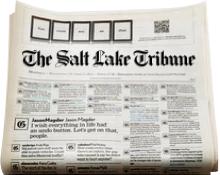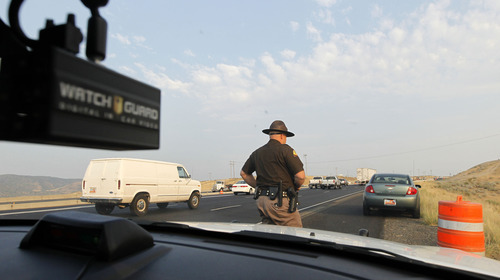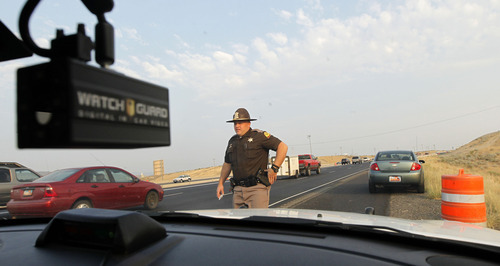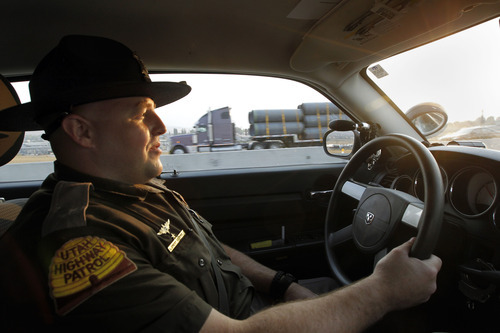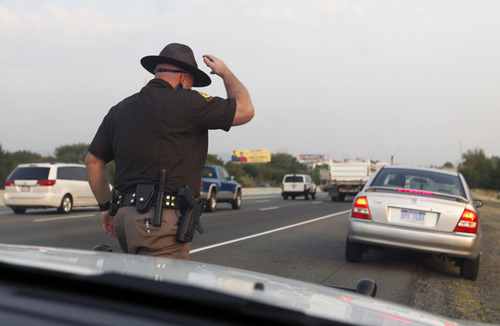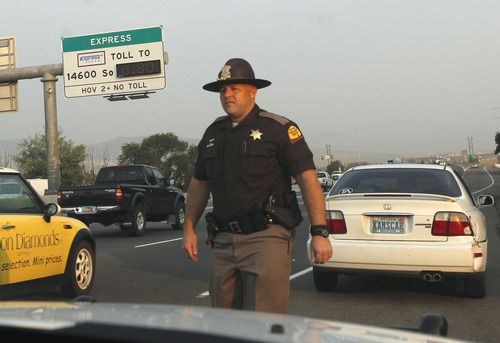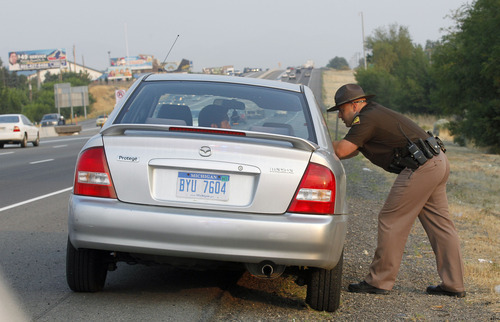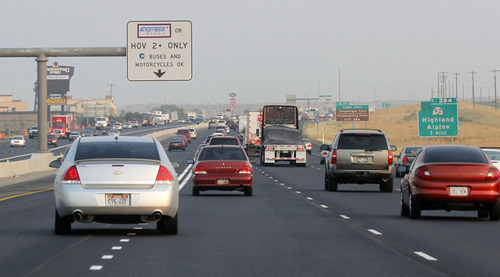This is an archived article that was published on sltrib.com in 2012, and information in the article may be outdated. It is provided only for personal research purposes and may not be reprinted.
Lehi • The car in the express lane cruises near the speed limit, but slows abruptly as it approaches a Highway Patrol car ahead in another lane. Trooper Emery Calkins notices that in his mirror — taking it as a sign the car may have only a single driver, instead of the two occupants required in such lanes.
Calkins slows to let the car catch up, but the car slows even more. Calkins then almost stops. So the car finally passes — and, sure enough, the driver is alone. Calkins flips on his flashing lights and pulls it over.
"People wonder how we spot single riders. They usually do something like that," Calkins says.
After giving the driver a warning, he relays her story.
"She said she was running late after work and had to get to school, so she popped over in that lane" to pass slower traffic.
Troopers hear such excuses often, especially this week as the Utah Highway Patrol held an express-lane enforcement blitz on Interstate 15. It comes after state studies found that one of every six cars in Utah express lanes is breaking the rules — a rate so high that it could bring federal sanctions if it is not lowered over time.
Thursday was Day 3 of the planned three-day blitz.
"Violations are way down," Calkins says. "Apparently, the word is out."
Still, Calkins is kept plenty busy, repeatedly pulling over violators during the morning rush hour as a Salt Lake Tribune reporter and photographer ride along. Lots of cars can be spotted pulled over by other troopers in the blitz.
Five minutes after leaving Orem, Calkins spots a car far ahead in a regular lane that is tailgating. Without signalling, it crosses illegally over double-white lines into the express lane — forcing a car there to hit its brakes — and speeds ahead.
Calkins catches up, flips on his flashing lights and signals the car to pull off to the right. Instead, it pulls to the left, where little shoulder exists, and stops. That blocks the express lane. Calkins uses a loudspeaker to tell the driver to move to the right. The car sits still. Calkins runs up to the driver and tells him he will help with his flashing lights to move him off to the right so they do not block the lane.
"I told him I could cite him for reckless driving and have his car impounded" for multiple violations of tailgating, speeding, illegally crossing a double-white line and being a single driver in a carpool lane, Calkins says. "I bet all the guys he passed like that were cheering when I pulled him over." He adds that motorists often flash thumbs-up signs to troopers nabbing such aggressive drivers.
Calkins said this driver had an interesting excuse for driving in the HOV (high-occupancy vehicle) lane by himself. "He said he thought HOV-2 meant you could go into it when two cars were close together."
But it is the driver's lucky day. Calkins only gives him a warning — as he does with all the drivers he pulls over during the Thursday ride-along.
"It's not always about writing tickets. It's about education," he says, noting that during the blitz he can pull over more cars during the peak commuting hours if he doesn't take time to write tickets. Everyone he pulls over vows not to break express lane rules again and is happy to escape the fine of up to $100.
"They will tell their friends what happened, and word will spread," he said.
That's what officials want to happen.
A state study in February showed that 17 percent of motorists in express lanes commit some violation, from crossing double-white lines to having a single occupant.
The federal government expects violation rates to be between 8 and 15 percent, says Mindy Nelson, spokeswoman for the Utah Department of Transportation. If rates stay higher than that, the state could face financial sanctions. So UDOT launched an advertising campaign and followed up with the enforcement blitz.
"I'd say that impatience may be the biggest reason for violations," says Calkins, a seven-year veteran of the Highway Patrol. "Drivers are stuck in traffic and see an open lane and take it. … But it is never safe to cross the double-white line, even if it looks like no one is coming."
Speeds in HOV lanes are usually faster. Drivers there are not expecting vehicles to cross double-white lines in front of them — and may not have time to react.
Calkins shows that troopers know the best hunting ground for violators. Near the Point of the Mountain in Lehi, he points to traffic backed up in regular lanes while HOV-lane traffic is speeding along. He says it often proves just too great a temptation for solo drivers.
Calkins pulls into a turnaround in the median to wait for the next violator. It doesn't take long — no more than a minute. Spotting several cars that jump the white line behind him, he pulls out and tracks down one that appears to cross back once she sees the trooper's cruiser.
He deals with her, then climbs back behind the wheel.
"Her story was that she was almost in an accident [with the car in front of her], so she had to cross the double-white line to avoid it, and then crossed back later. So we talked about following too close," Calkins said. "She almost talked me into giving her a ticket instead of out of one."
Almost, but not quite. —
HOV rules
Express lanes in Utah allow only carpoolers (with at least two occupants), buses, motorcycles, C-decal (clean-fuel) vehicles and single riders who pay a toll through an electronic reader available from UDOT. Entering and exiting the lanes are allowed only in designated stretches with dotted white lines, and are not allowed in areas with solid double-white lines.
UDOT studies have found that express lanes carry twice as many people as regular lanes because of carpooling, and speeds average 10 mph faster. UDOT says that helps reduce congestion in other lanes. —
Utah highways by the number
Licensed drivers 1.8 million
Registered motor vehicles 2 million
Vehicle miles traveled 26.4 billion
Crashes 50,270
Injuries 21,290
Fatalities 233
Source: 2011 Annual Statistical Summary, Utah Department of Transportation
